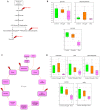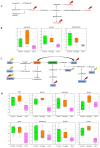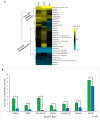Metabolomic Profiling of Soybeans (Glycine max L.) Reveals the Importance of Sugar and Nitrogen Metabolism under Drought and Heat Stress
- PMID: 28587097
- PMCID: PMC5489793
- DOI: 10.3390/plants6020021
Metabolomic Profiling of Soybeans (Glycine max L.) Reveals the Importance of Sugar and Nitrogen Metabolism under Drought and Heat Stress
Abstract
Soybean is an important crop that is continually threatened by abiotic stresses, especially drought and heat stress. At molecular levels, reduced yields due to drought and heat stress can be seen as a result of alterations in metabolic homeostasis of vegetative tissues. At present an incomplete understanding of abiotic stress-associated metabolism and identification of associated metabolites remains a major gap in soybean stress research. A study with a goal to profile leaf metabolites under control conditions (28/24 °C), drought [28/24 °C, 10% volumetric water content (VWC)], and heat stress (43/35 °C) was conducted in a controlled environment. Analyses of non-targeted metabolomic data showed that in response to drought and heat stress, key metabolites (carbohydrates, amino acids, lipids, cofactors, nucleotides, peptides and secondary metabolites) were differentially accumulated in soybean leaves. The metabolites for various cellular processes, such as glycolysis, the tricarboxylic acid (TCA) cycle, the pentose phosphate pathway, and starch biosynthesis, that regulate carbohydrate metabolism, amino acid metabolism, peptide metabolism, and purine and pyrimidine biosynthesis, were found to be affected by drought as well as heat stress. Computationally based regulatory networks predicted additional compounds that address the possibility of other metabolites and metabolic pathways that could also be important for soybean under drought and heat stress conditions. Metabolomic profiling demonstrated that in soybeans, keeping up with sugar and nitrogen metabolism is of prime significance, along with phytochemical metabolism under drought and heat stress conditions.
Keywords: crop yield; drought stress; heat stress; metabolomic profiling; phytochemicals; soybean.
Conflict of interest statement
The authors declare no conflict of interest.
Figures








Similar articles
-
Transcriptomic and metabolomic profiling of melatonin treated soybean (Glycine max L.) under drought stress during grain filling period through regulation of secondary metabolite biosynthesis pathways.PLoS One. 2020 Oct 30;15(10):e0239701. doi: 10.1371/journal.pone.0239701. eCollection 2020. PLoS One. 2020. PMID: 33125378 Free PMC article.
-
Differential Physio-Biochemical and Metabolic Responses of Peanut (Arachis hypogaea L.) under Multiple Abiotic Stress Conditions.Int J Mol Sci. 2022 Jan 8;23(2):660. doi: 10.3390/ijms23020660. Int J Mol Sci. 2022. PMID: 35054846 Free PMC article.
-
Redox markers for drought-induced nodule senescence, a process occurring after drought-induced senescence of the lowest leaves in soybean (Glycine max).Ann Bot. 2015 Sep;116(4):497-510. doi: 10.1093/aob/mcv030. Epub 2015 Apr 7. Ann Bot. 2015. PMID: 25851140 Free PMC article.
-
Proteomic approaches to uncover the flooding and drought stress response mechanisms in soybean.J Proteomics. 2018 Feb 10;172:201-215. doi: 10.1016/j.jprot.2017.11.006. Epub 2017 Nov 11. J Proteomics. 2018. PMID: 29133124 Review.
-
Drought or/and Heat-Stress Effects on Seed Filling in Food Crops: Impacts on Functional Biochemistry, Seed Yields, and Nutritional Quality.Front Plant Sci. 2018 Nov 27;9:1705. doi: 10.3389/fpls.2018.01705. eCollection 2018. Front Plant Sci. 2018. PMID: 30542357 Free PMC article. Review.
Cited by
-
Targeted and untargeted metabolomics reveals deep analysis of drought stress responses in needles and roots of Pinus taeda seedlings.Front Plant Sci. 2023 Jan 31;13:1031466. doi: 10.3389/fpls.2022.1031466. eCollection 2022. Front Plant Sci. 2023. PMID: 36798806 Free PMC article.
-
Adaptation Strategies to Improve the Resistance of Oilseed Crops to Heat Stress Under a Changing Climate: An Overview.Front Plant Sci. 2021 Dec 15;12:767150. doi: 10.3389/fpls.2021.767150. eCollection 2021. Front Plant Sci. 2021. PMID: 34975951 Free PMC article. Review.
-
Unraveling Key Metabolomic Alterations in Wheat Embryos Derived from Freshly Harvested and Water-Imbibed Seeds of Two Wheat Cultivars with Contrasting Dormancy Status.Front Plant Sci. 2017 Jul 12;8:1203. doi: 10.3389/fpls.2017.01203. eCollection 2017. Front Plant Sci. 2017. PMID: 28747920 Free PMC article.
-
Past and Future of Plant Stress Detection: An Overview From Remote Sensing to Positron Emission Tomography.Front Plant Sci. 2021 Jan 27;11:609155. doi: 10.3389/fpls.2020.609155. eCollection 2020. Front Plant Sci. 2021. PMID: 33584752 Free PMC article. Review.
-
Insight Into the Prospects for the Improvement of Seed Starch in Legume-A Review.Front Plant Sci. 2019 Oct 31;10:1213. doi: 10.3389/fpls.2019.01213. eCollection 2019. Front Plant Sci. 2019. PMID: 31736985 Free PMC article. Review.
References
-
- Deryng D., Conway D., Ramankutty N., Price J., Warren R. Global crop yield response to extreme heat stress under multiple climate change futures. Environ. Res. Lett. 2014;9:3. doi: 10.1088/1748-9326/9/3/034011. - DOI
-
- Chebrolu K.K., Fritschi F.B., Ye S., Krishnan H.B., Smith J.R., Gillman J.D. Impact of heat stress during seed development on soybean seed metabolome. Metabolomics. 2016;12:28. doi: 10.1007/s11306-015-0941-1. - DOI
LinkOut - more resources
Full Text Sources
Other Literature Sources
Miscellaneous

